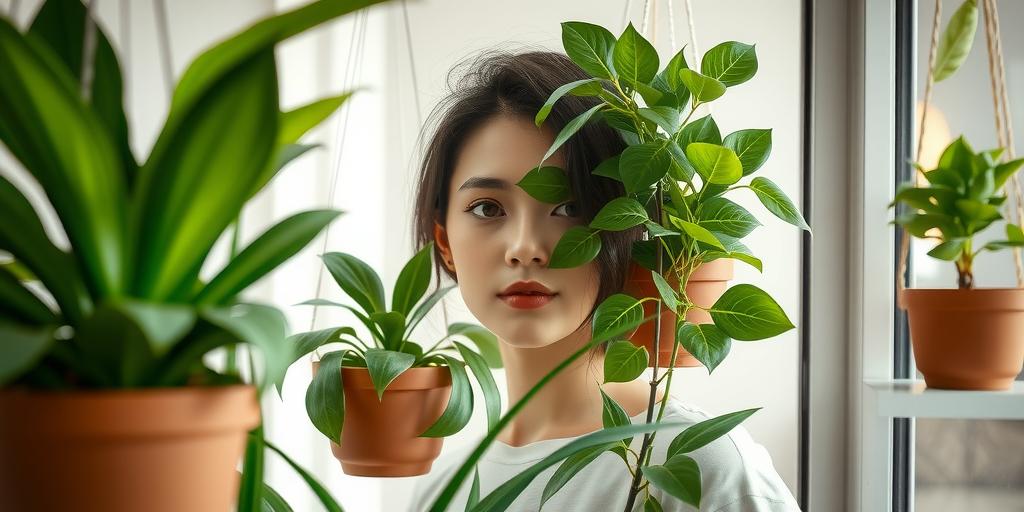
Best Air Purifying Low Light Hanging Plants for Your Home (2025)
Discover the best air-purifying low-light hanging plants for your home in 2025! These easy-care plants improve indoor air quality while adding greenery to dim spaces.
Introduction
Did you know indoor air can be up to 5 times more polluted than outdoor air? Luckily, nature has a solution—low-light hanging plants that purify the air while thriving in dim corners! Whether you live in an apartment with limited sunlight or just want to add a touch of green to your space, these plants are perfect. In this guide, we’ll explore the best air-purifying hanging plants that require minimal light and care. Let’s dive in!
Why Choose Air-Purifying Hanging Plants for Low Light?
If you’re looking for an easy way to improve indoor air quality while adding greenery to your space, air-purifying hanging plants are a fantastic choice. Not only do they help filter out harmful toxins, but they also thrive in low-light conditions—making them perfect for apartments, offices, or rooms with limited sunlight.
Benefits of Indoor Plants for Air Quality
You may have heard of NASA’s Clean Air Study, which found that certain houseplants can remove toxins like formaldehyde, benzene, and xylene from the air. These pollutants are commonly found in household products, furniture, and even cleaning supplies. By introducing air-purifying plants into your home, you’re creating a healthier living environment naturally.
Advantages of Hanging Plants in Small or Dim Spaces
Hanging plants are a great solution if you’re short on floor or shelf space. They add vertical interest and can brighten up dark corners where other plants might struggle. Plus, trailing vines create a beautiful cascading effect, making them a stylish addition to any room.
Low-Maintenance Nature for Busy Homeowners
Many air-purifying hanging plants are incredibly forgiving, requiring minimal care. If you forget to water them occasionally or don’t have the brightest space, they’ll still thrive. This makes them ideal for busy people who want greenery without the hassle.
Top Air-Purifying Low Light Hanging Plants
1. Spider Plant (Chlorophytum comosum)
Spider plants are one of the easiest air-purifying plants to grow. They’re excellent at removing formaldehyde, xylene, and toluene—common toxins found in household products.
-
Light & Care: Thrives in indirect light and can tolerate low light. Water when the top inch of soil feels dry.
-
Bonus Feature: Produces baby spiderettes that you can propagate to grow new plants—great for sharing with friends!
2. Pothos (Epipremnum aureum)
Pothos is a superstar when it comes to filtering indoor air. It tackles benzene, formaldehyde, and even carbon monoxide.
-
Light & Care: Does well in low to moderate light. Water when the soil is dry to the touch.
-
Bonus Feature: Fast-growing and adaptable—perfect for beginners or those who want quick results.
3. English Ivy (Hedera helix)
English Ivy is particularly effective against mold spores and airborne toxins, making it a great choice for bathrooms or humid spaces.
-
Light & Care: Prefers cooler temperatures and indirect light. Keep the soil consistently moist but not soggy.
-
Bonus Feature: Its trailing vines look stunning in hanging baskets, adding a classic, elegant touch.
4. Heartleaf Philodendron (Philodendron hederaceum)
This plant is a powerhouse at filtering formaldehyde and other volatile organic compounds (VOCs).
-
Light & Care: Tolerates low light and irregular watering, making it super low-maintenance.
-
Bonus Feature: The heart-shaped leaves and trailing vines make it a beautiful decorative piece.
5. Boston Fern (Nephrolepis exaltata)
Boston Ferns act as natural humidifiers while purifying the air. They’re especially good for dry indoor environments.
-
Light & Care: Prefers indirect light and consistent moisture—mist occasionally to keep humidity levels up.
-
Bonus Feature: Their feathery fronds add a soft, elegant look to any hanging display.
How to Care for Low Light Hanging Plants
Light Requirements: Best Spots for Indirect Light
Even though these plants tolerate low light, they still need some brightness to thrive. Place them near north-facing windows or a few feet away from brighter windows where they’ll get filtered light. Avoid direct sunlight, which can scorch their leaves.
Watering Tips: Avoid Overwatering
Overwatering is the most common killer of houseplants. Always check the soil moisture before watering—stick your finger an inch into the soil. If it’s dry, it’s time to water. If it’s still damp, wait a few more days.
Fertilization: Best Organic Fertilizers
Since low-light plants grow slower, they don’t need frequent feeding. Use a diluted organic fertilizer (like fish emulsion or worm castings) every 4-6 weeks during the growing season (spring and summer).
Pruning & Maintenance
Regularly trim dead or yellowing leaves to encourage new growth. Pinching back trailing vines can also help keep the plant bushy and full.
Styling Tips for Hanging Plants in Your Home
Best Hanging Planters for Aesthetics and Function
Choose planters with good drainage to prevent root rot. Macramé hangers, ceramic pots, or woven baskets all add a stylish touch while keeping plants healthy.
Creative Placement Ideas
-
Living Room: Hang near windows or above shelves for a cascading effect.
-
Kitchen: Place near a sink or window where humidity levels are higher.
-
Bathroom: Ideal for moisture-loving plants like English Ivy or Boston Fern.
Mixing Different Trailing Plants
Combine different textures and leaf shapes for a lush, layered look. Try pairing a Spider Plant with a Pothos for contrast in color and form.
Common Problems & Solutions
Yellowing Leaves?
This is often a sign of overwatering or poor drainage. Check the soil and adjust your watering schedule. If the pot doesn’t have drainage holes, consider repotting.
Pests Like Spider Mites?
If you notice tiny webs or speckled leaves, wipe the foliage with a mix of water and mild soap or neem oil.
Slow Growth?
If your plant isn’t thriving, it might need more light or nutrients. Move it to a slightly brighter spot or give it a gentle fertilizer boost.
By choosing the right plants and following these care tips, you’ll enjoy cleaner air and a greener home—even in low-light spaces!
Conclusion
Adding air-purifying low-light hanging plants to your home is a simple way to boost air quality and enhance your décor. From the resilient Spider Plant to the elegant Boston Fern, there’s a perfect plant for every space. Ready to transform your home into a greener, healthier oasis? Pick your favorite plant and get started today!
